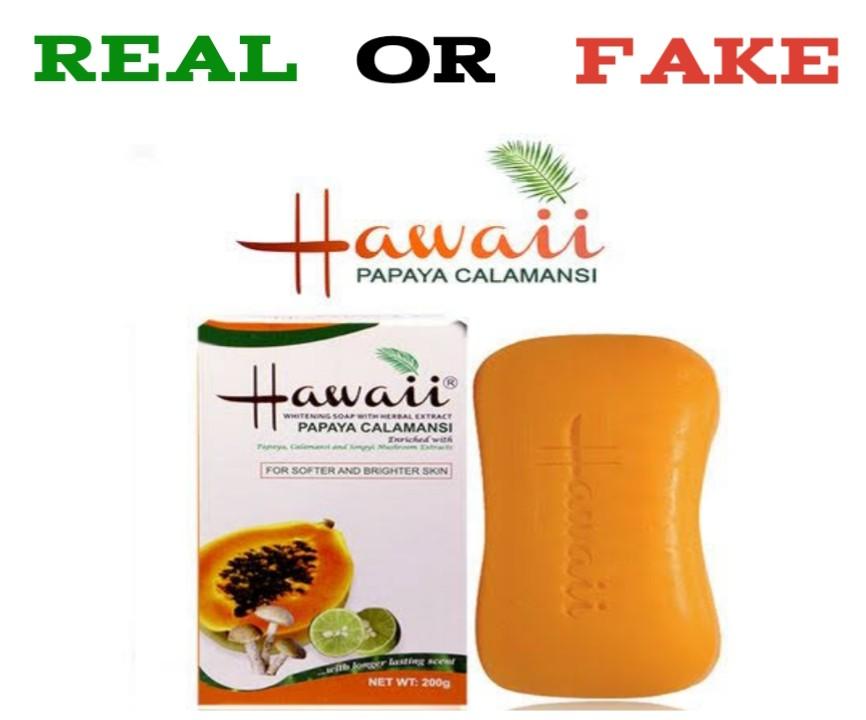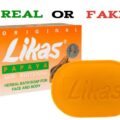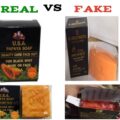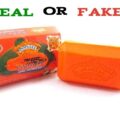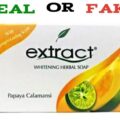Hawaii Papaya Calamansi soap is specially formulated with purely combined herbal ingredients of Papaya, Calamansi, and Songyi Mushroom. Calamansi extract naturally whitens delicate skin while Papaya extract subtly exfoliates dead skin cells resulting from harsh climatic and environmental conditions. Hawaii Papaya Calamansi has nutrients to promote healthier skin. Papaya soap is rich in vitamin C, an antioxidant that can reduce irregular pigmentation and stimulate collagen production. The soap also contains vitamin A, another important nutrient for the skin. It promotes the production of new skin cells and may help reduce dark spots, blemishes, and scars.
How To Identify Original Hawaii Papaya Calamansi Soap vs Fake
Fake soaps can wreck havoc on your skin, as they often cause dry, dehydrated skin due to their high pH, your skin needs to maintain a specific, fairly acidic pH to function properly. The acid mantle, a thin, protective layer, is primarily composed of sebum, the skin’s naturally produced oil. Its integrity is susceptible to irregularities caused by internal and external factors, like diet, pollutants, and fake soaps. To keep skin healthy, the acid mantle needs to be able to do its job and to do its job, we need to avoid cleansers that could upset its pH balance.
According to the FBI, the Internet has given consumers widespread access to health and beauty products some labeled with “anti-aging” properties that they don’t know are fake. Government and industry studies and testing have discovered dangerous ingredients within counterfeit “anti-aging” products. Fraudulent cosmetics may contain arsenic, beryllium, and cadmium all known carcinogens along with high levels of aluminum and dangerous levels of bacteria from sources such as urine. Some of these products have caused conditions like acne, psoriasis, rashes, and eye infections. A fake Hawaii Soap is a bit difficult to distinguish from the Original, the fake orange soaps are slightly darker than the original. Here are other tips to help you avoid buying a fake Hawaii papaya soap.
Hawaii Papaya Soap packaging: Back in the day, you could spot a counterfeit based solely on shoddy packaging. Now, that’s a lot harder to do. Now, the packaging can look almost identical.” In other words, just because something looks legit doesn’t mean that it actually is, so it’s important to test the actual product or check out the retailer selling the Hawaii papaya soap before slathering it all over your body. ALSO SEE: How To Spot Original Kojie San Soap vs Fake
Buy Hawaii Papaya Soap from a reputable seller: When you purchase products directly from a brand or an authorized retailer, you know what you’re getting. Elsewhere on the Internet, it’s not so clear. Websites that work with third parties which many, many people turn to for their beauty products are hotbeds for fakes, and if you think you’re getting a great deal on something that’s usually super expensive or sold out elsewhere, chances are it’s probably too good to be true.
Check the Hawaii Papaya Soap reviews: If you are going to buy skin care on Amazon, for example, which has many third-party sellers, it’s important to research by reading a seller’s reviews. “If a seller has repeated negative reviews, or reviews that your gut tells you are ‘staged’ or ‘fake’ because they all contain nearly the exact same language, do not purchase your Hawaii Papaya Soap from that seller even if the price is so compelling and attractive.
Test the Hawaii Papaya Soap: Testing new products on your arm or hand is always important, but it’s especially important in the case of counterfeits. If a Hawaii Papaya Soap you’ve been using forever is suddenly giving you contact dermatitis when you try it, it’s a good sign that it’s a fake Hawaii Papaya Soap.
Side Effects of Hawaii Soap
This soap is made with papaya extract. Papaya-based soap may cause severe allergic reactions in sensitive people. Contact dermatitis is a red, itchy rash caused by direct contact with a substance or an allergic reaction to it. The rash isn’t contagious or life-threatening, but it can be very uncomfortable. Many substances can cause such reactions, including soaps, cosmetics, fragrances, jewelry, and plants. Contact dermatitis usually occurs on areas of your body that have been directly exposed to the soap. The rash usually develops within minutes to hours of exposure and can last two to four weeks.
Signs and symptoms of contact dermatitis include:
- A red rash
- Itching, which may be severe
- Dry, cracked, scaly skin
- Bumps and blisters, sometimes with oozing and crusting
- Swelling, burning, or tenderness
When to see a doctor
See your doctor if:
- The rash is so uncomfortable that you are losing sleep or are distracted from your daily activities
- The rash is sudden, painful, severe, or widespread
- You’re embarrassed by the way your skin looks
- The rash doesn’t get better within three weeks
- The rash affects your face or genitals
Seek immediate medical care in the following situations:
You think your skin is infected. Clues include fever and pus oozing from blisters.
Your lungs, eyes, or nasal passages are painful and inflamed, perhaps from inhaling an allergen.
You think the rash has damaged the mucous lining of your mouth and digestive tract. READ: Best Cream For Fair Skin In Nigeria
This soap also contains calamansi (Citrus × microcarpa), also known as calamondin or Philippine lime. The acidic nature of the fruit may cause a stinging or burning sensation sometimes. Do a patch test before including calamansi soap in your daily skincare routine. Women with sensitive skin should skip it anyway. Also, make sure that you do not go out in the sun right after treating your skin with calamansi. The strong acidic properties of the ingredient will cause you sunburns otherwise. READ: How To Identify Original Likas Soap vs Fake


